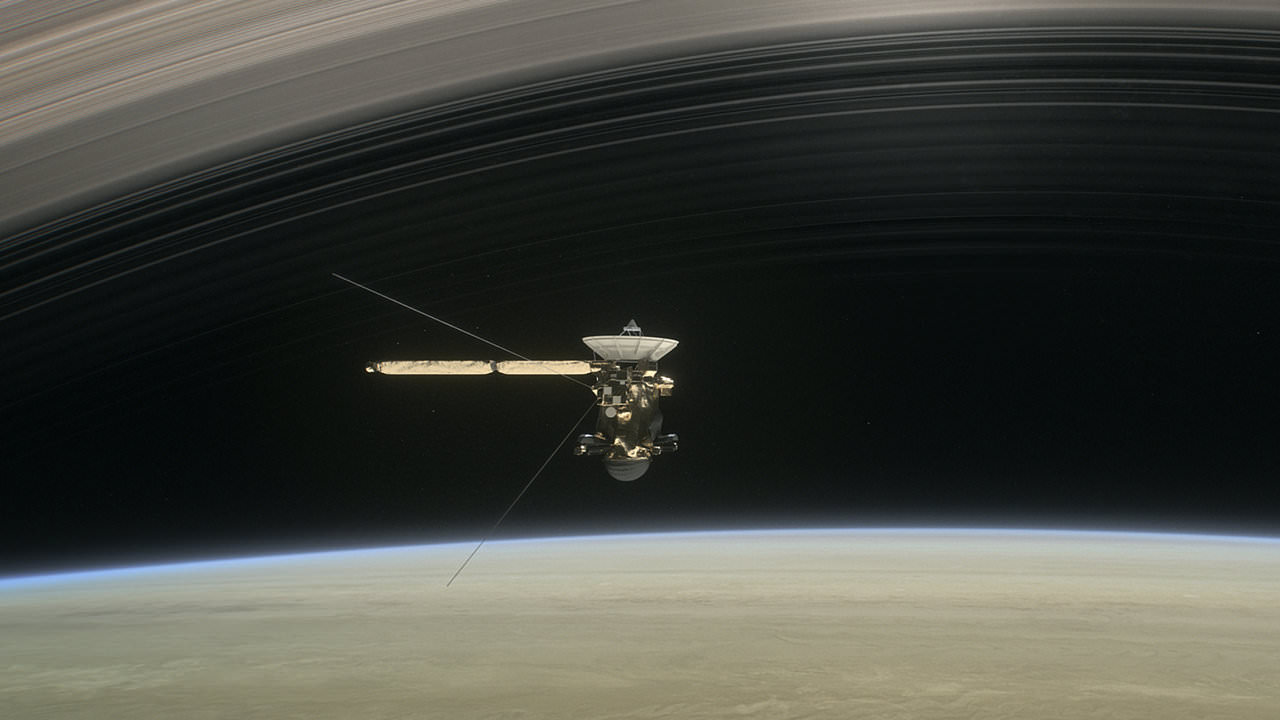In 1997, the NASA/ESA Cassini-Huygens mission launched from Earth and began its long journey towards the Saturn system. In 2004, the Cassini orbiter arrived around Saturn and would spend the next thirteen years studying the gas giant, its rings, and its system of Moons. On September 15th, 2017, the mission ended when the probe entered Saturn’s upper atmosphere and burned up.
This was known as Cassini’s “Grand Finale“, which began with the probe plunging into the unexplored region that lies between Saturn’s atmosphere and its rings and culminated with live coverage of it entering the atmosphere. In honor of the mission and NASA’s outstanding coverage of its final months, NASA was recently nominated for an Emmy Award by The Academy of Television Arts & Sciences.
The award is in the category of Outstanding Original Interactive Program, which recognizes the JPL’s multi-month digital campaign that celebrated the mission’s science and engineering accomplishments – which included news, web, education, television and social media efforts. It is also a nod to the agency’s success in communicating why the spacecraft concluded its mission in the skies of Saturn.
Essentially, the spacecraft was intentionally destroyed in Saturn’s atmosphere to prevent the possibility of it contaminating any of Saturn’s moons. Throughout the thirteen years it spent studying the Saturn system, Cassini found compelling evidence for the possible existence of life on Titan and in Enceladus’ interior ocean. In addition, scientists have speculated that there may be interior oceans within Rhea and Dione.
In this respect, Cassini ended its mission the same way the Galileo probe did in 2003. After spending 8 years studying Jupiter and its system the moons, the probe crashed into the gas giant’s upper atmosphere in order to prevent any possible contamination of Europa or Ganymede, which are also thought to have an interior oceans that could support life.
The “Grand Finale” campaign began on April 26th, 2017, and continued until the craft entered Saturn’s atmosphere on Sept. 15th, 2017, with the spacecraft sending back science to the very last second. The campaign utilized several different forms of media, was interactive, and was very comprehensive, providing regular updates and vital information about the mission.
As NASA indicated on their Cassini website:
“The multi-faceted campaign included regular updates on Twitter, Facebook, Snapchat, Instagram and the Cassini mission website; multiple live social, web and TV broadcasts during which reporter and public questions were answered; a dramatic short film to communicate the mission’s story and preview its endgame; multiple 360-degree videos, including NASA’s first 360-degree livestream of a mission event from inside JPL mission control; an interactive press kit; a steady drumbeat of articles to keep fans updated with news and features about the people behind the mission; state-standards aligned educational materials; a celebration of art by amateur space enthusiasts; and software to provide real-time tracking of the spacecraft, down to its final transmission to Earth.”
The short film, titled “For Your Consideration: The NASA Cassini Grand Finale“, showcases the missions many accomplishments, pays tribute to all those who made it happen and who helped inform the public and communicate the importance of the mission.
The Primetime Emmys will be awarded be on September 17th in Los Angeles. The Creative Arts Emmys, which includes interactive awards, will be presented during a separate ceremony on Saturday, Sept. 15th, at the Microsoft Theatre in Los Angeles. Other contenders include Back to the Moon, a Google Spotlight Stories App; Blade Runner 2049: Memory Lab, Coco VR, and Spiderman Homecoming, three Oculus VR experiences.
And be sure to check out the videos, FYC: NASA Cassini Grand Finale, below:
Further Reading: NASA


If you read the comments, you will notice that many of the viewers were deeply moved by Cassini’s “sacrifice” at the end of the film. I was also, but then, I get that way every time a beloved probe, telescope, or space station meets the end of its run.
It’s a testament to the quality of the narration and animation that so many of the general public could be moved to emotion by the clip. Based on that, I think that it certainly does deserve consideration for one of their awards.
I haven’t seen this video before. And it was indeed a good watch. Wouldn’t expect an Emmy nomination though.